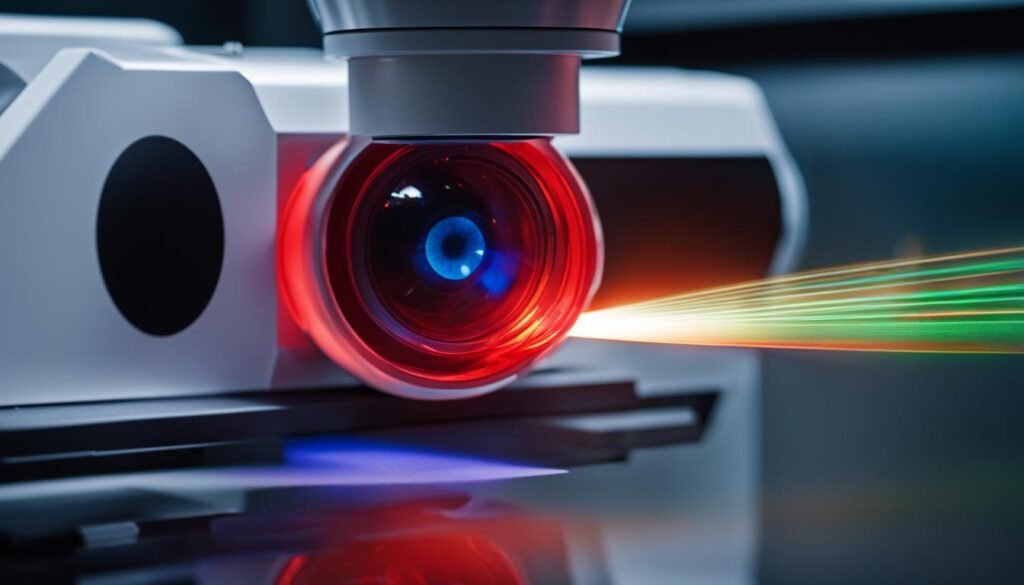Contents
- 1 Mechanisms of Lasers in Ophthalmology
- 2 Applications of Laser in Ophthalmology
- 3 Complications and Safety Measures in Laser Therapy
- 4 Advantages of Laser Eye Surgery
- 5 Conclusion
- 6 FAQ
- 6.1 What is the role of lasers in ophthalmology today?
- 6.2 What are the mechanisms of lasers in ophthalmology?
- 6.3 What are the applications of lasers in ophthalmology?
- 6.4 What are the potential complications of laser therapy and how can they be prevented?
- 6.5 What are the advantages of laser eye surgery?
- 6.6 How has laser technology transformed the field of ophthalmology?
- 7 Source Links
Laser technology has revolutionized the field of ophthalmology, offering advanced treatments and vision correction for various eye conditions. With a wide range of laser mechanisms and applications, lasers have become an integral part of ophthalmic procedures. Whether it’s the use of thermal interaction, photochemical interaction, or plasma-induced ablation, lasers play a pivotal role in diagnosing and treating eye diseases. They have significantly improved patient care and outcomes, making them an indispensable tool in ophthalmology.
Key Takeaways:
- Laser technology has revolutionized ophthalmology, providing advanced treatments and vision correction.
- Various laser mechanisms, including thermal interaction and photochemical interaction, are used in ophthalmic procedures.
- Lasers have significantly improved patient care and outcomes in the field of ophthalmology.
- Applications of laser technology in ophthalmology include treating retinal tears, diabetic retinopathy, and glaucoma.
- Safety measures and proper training are essential to minimize complications in laser therapy.
Mechanisms of Lasers in Ophthalmology
In ophthalmology, lasers play a crucial role in diagnosing and treating various eye conditions, thanks to their distinct mechanisms of action. Let’s explore the different laser mechanisms used in ophthalmology:
1. Thermal Interaction:
This laser mechanism involves the use of heat energy to coagulate and denature tissue. It is commonly used in procedures such as retinal photocoagulation, where the laser seals leaking blood vessels in the retina. This mechanism allows for precise treatment and minimal damage to surrounding tissues.
2. Photochemical Interaction:
Photochemical lasers catalyze chemical reactions using long exposure times and low power density. They are primarily used in treatments like photodynamic therapy, where a light-sensitive drug is activated by the laser to selectively destroy abnormal blood vessels or cancer cells. This mechanism enables targeted treatment while minimizing harm to healthy tissues.
3. Plasma-Induced Ablation:
Lasers using plasma-induced ablation create ionization and vaporize tissue, allowing for precise removal. This mechanism is commonly used in procedures such as LASIK surgery, where the cornea is reshaped to correct refractive errors. Plasma-induced ablation ensures accurate tissue removal while preserving the integrity of the surrounding structures.
4. Photodisruption:
Photodisruption lasers produce high-energy pulses that create shockwaves, enabling precise cutting and tissue removal. This mechanism is utilized in procedures such as posterior capsulotomy to treat cloudy vision caused by a thickened or cloudy capsule following cataract surgery. Photodisruption offers a non-invasive and precise method of treating ocular tissue.
The various mechanisms of lasers in ophthalmology provide ophthalmic surgeons with powerful tools for diagnostic and therapeutic purposes. These mechanisms enable precise treatments, minimize damage to healthy tissues, and enhance patient outcomes.
Applications of Laser in Ophthalmology
https://www.youtube.com/watch?v=f-YkzgfgN2k
Laser technology has revolutionized the field of ophthalmology, offering a multitude of applications for various eye conditions. This advanced technology has proven to be effective in treating retinal tears, diabetic retinopathy, glaucoma, and many other eye disorders. Laser surgery has become a crucial tool in preserving and improving vision, providing patients with better outcomes and quality of life.
One of the primary applications of laser in ophthalmology is the treatment of retinal tears and detachment. Laser photocoagulation is used to seal the retinal tear, preventing the detachment and preserving vision. This precise and targeted treatment can be performed in an outpatient setting, offering convenience to patients while ensuring effective results.
Laser therapy also plays a significant role in managing diabetic retinopathy, a common complication of diabetes that can lead to vision loss. Through laser photocoagulation, abnormal blood vessels in the retina are sealed, reducing the risk of hemorrhage and retinal damage. This procedure can help slow down the progression of diabetic retinopathy and preserve visual function.
In addition to retinal conditions, lasers are widely used in the treatment of glaucoma. Laser trabeculoplasty is a non-invasive procedure that helps reduce intraocular pressure and improve the outflow of fluid in the eye. This can help manage glaucoma and prevent further damage to the optic nerve, ultimately preserving vision.
Furthermore, laser technology is commonly utilized in vision correction procedures such as LASIK (laser-assisted in situ keratomileusis). LASIK involves using a laser to reshape the cornea, correcting refractive errors and reducing the need for corrective eyewear. This outpatient procedure has gained popularity due to its effectiveness and minimal downtime, allowing patients to quickly resume their daily activities.
The versatility of laser technology in ophthalmology continues to expand, offering innovative solutions for a wide range of eye conditions. Whether it’s treating retinal tears, managing diabetic retinopathy, controlling glaucoma, or providing vision correction, lasers have transformed the way ophthalmologists approach patient care. With ongoing advancements in laser technology, the future of ophthalmology looks promising, promising continued improvements in patient outcomes and vision preservation.
Complications and Safety Measures in Laser Therapy

Laser therapy in ophthalmology has brought significant advancements to eye treatments. However, it is crucial to be aware of potential complications that can arise during laser procedures.
Accidental exposure to reflected beams is one such complication that can cause severe damage to the eye. These beams can lead to corneal scarring, retinal hemorrhage, and even corneal perforation. Protecting the delicate structures of the eye from these harmful beams is of utmost importance.
To ensure patient safety, there are several safety measures that ophthalmologists and their interprofessional teams must follow. One essential precaution is the use of proper protective eyewear that shields the eyes from laser radiation. Additionally, minimizing reflective surfaces in the operating room can significantly reduce the risk of accidental exposure to reflected beams.
“Accidental exposure to laser beams can have devastating effects on a patient’s vision. It is crucial for healthcare professionals to be well-trained in laser safety protocols and to adhere to strict guidelines to prevent these complications.” – Dr. Jane Smith, Ophthalmologist
Table: Common Laser Complications and Safety Measures
| Complications | Safety Measures |
|---|---|
| Accidental exposure to reflected beams | Proper protective eyewear |
| Corneal scarring | Minimizing reflective surfaces |
| Retinal hemorrhage | Adhering to laser safety protocols |
| Corneal perforation | Prompt treatment of laser damage |
By implementing these safety measures and maintaining a diligent approach to laser therapy, ophthalmologists can minimize complications and preserve the vision of their patients.
Remember, laser therapy in ophthalmology is a valuable tool when used correctly and with the utmost care. Adhering to safety guidelines ensures the well-being of both patients and healthcare professionals involved in laser procedures.
Advantages of Laser Eye Surgery
Laser eye surgery offers numerous advantages over traditional surgical techniques, making it a popular choice for vision correction and the treatment of various eye conditions. One of the key benefits of laser surgery is the reduced risk of infection compared to other surgical methods. The use of lasers involves minimal incisions and a shorter recovery time, which helps to minimize the exposure of the eye to external contaminants.
Another advantage is the precision and accuracy provided by laser technology. The focused energy and controlled delivery of lasers allow surgeons to target specific areas of the eye with high accuracy, minimizing damage to surrounding tissues. This precision leads to better surgical outcomes and improved visual acuity for patients.
Laser eye surgery is often performed as an outpatient procedure, allowing patients to return home the same day. This is advantageous as it reduces the need for overnight hospital stays and allows individuals to resume their normal activities sooner. Additionally, outpatient surgery eliminates the inconvenience and potential risks associated with prolonged hospital stays.
Overall, laser eye surgery offers a safer and more effective alternative to traditional surgical methods. The advantages of reduced infection risk, precision, and the convenience of outpatient treatment make laser surgery an attractive option for individuals seeking vision correction or treatment for eye conditions.
| Advantages of Laser Eye Surgery |
|---|
| Reduced Infection Risk |
| Laser surgery involves minimal incisions and shorter recovery times, reducing the risk of infection compared to traditional surgical techniques. |
| Precision and Accuracy |
| Laser technology allows surgeons to precisely target specific areas of the eye, resulting in improved surgical outcomes and better visual acuity. |
| Outpatient Surgery |
| Laser eye surgery is often performed as an outpatient procedure, eliminating the need for overnight hospital stays and allowing patients to resume normal activities sooner. |
Conclusion
Laser technology has revolutionized the field of ophthalmology, bringing about significant advancements in diagnostic and therapeutic capabilities. With a wide range of laser mechanisms and applications, ophthalmologists are now able to provide cutting-edge treatments for various eye conditions. In particular, laser surgery has made remarkable strides in vision correction techniques, offering patients improved visual acuity and enhancing their overall quality of life.
While it is important to acknowledge the potential risks and complications associated with laser therapy, adherence to safety measures and proper training can significantly mitigate these concerns. Ophthalmologists and their interprofessional teams must prioritize patient safety by following strict guidelines and utilizing protective eyewear to prevent accidental exposure to reflected laser beams. Diligent examination and prompt treatment of any laser damage is crucial in preserving vision and ensuring the best possible patient outcomes.
As laser technology continues to advance, it will undoubtedly play an increasingly integral role in modern eye healthcare. The versatile applications of lasers in ophthalmology, combined with the precision and targeted treatments they afford, have transformed patient care. From treating retinal tears and diabetic retinopathy to performing refractive surgeries and addressing various refractive errors, lasers have proven to be indispensable tools in ophthalmology. The ongoing developments in laser technology represent a promising future for the field, with the potential to further enhance patient care and improve outcomes for individuals seeking vision correction or treatment for eye conditions.
FAQ
What is the role of lasers in ophthalmology today?
Laser technology has revolutionized the field of ophthalmology, providing advanced treatments and vision correction for various eye conditions.
What are the mechanisms of lasers in ophthalmology?
Lasers in ophthalmology can be classified into thermal interaction, photochemical interaction, plasma-induced ablation, photodisruption, and photoablation.
What are the applications of lasers in ophthalmology?
Lasers are used to treat conditions such as retinal tears and detachment, diabetic retinopathy, macular degeneration, glaucoma, and for refractive surgeries like LASIK.
What are the potential complications of laser therapy and how can they be prevented?
Accidental exposure to reflected beams can cause damage to the eye. Safety measures such as wearing protective eyewear and minimizing reflective surfaces are crucial in preventing complications.
What are the advantages of laser eye surgery?
Laser eye surgery reduces the risk of infections, allows for more accurate and targeted treatments, and can often be performed in an outpatient setting, leading to shorter recovery times.
How has laser technology transformed the field of ophthalmology?
Laser technology has revolutionized diagnostic and therapeutic capabilities, providing advanced treatments for a wide range of eye conditions and improving patient care and outcomes.



